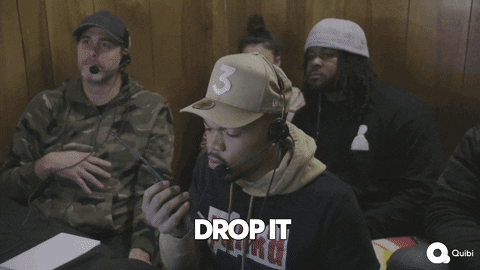Mic Drop #5: Quibi & Alternate Universe Quibi (…AUQUIBI?)
Revisiting my prediction from January and imagining AUQUIBI
I connect the dots across the OTT streaming marketplace for your competitive edge at PARQOR.com. Here, I will be highlighting and celebrating “mic drops” on my predictions from past PARQOR Member mailings.
This week, I revisit my predictions for Quibi from January, with an outline of what I think Jeffrey Katzenberg should have announced instead.
If you are an existing PARQOR Member, you can download the PDF of my predictions from January on Quibi for free, or if not, at the same link with the coupon code SUBSTACK (automatically appended to this link).
Revising Quibi
In January I wrote:
Prediction: Quibi's Turnstyle technology is disappointing, if not useless; odds are high it will have some hit content, and for this reason will pivot to TV apps in 6-12 months
On October 21, 2020, nine months to the day (!) after I wrote that (January 20, 2020) , and a day before it announced Quibi was shutting down, Variety reported:
Quibi’s quick-bite originals are now streaming on three connected-TV device platforms — Apple TV, Amazon’s Fire TV and Google TV/Android TV. But there might be nothing that can save Jeffrey Katzenberg’s struggling mobile subscription-video startup at this point.
Quibi’s Turnstyle technology was useless, and it did pivot to TV apps at 9 months, the exact midpoint between 6-12 months. Nailed that one.

I also wrote then:
A piece on The Verge about Quibi asked two good questions about Turnstyle, Quibi's unique feature:
* how many people want to routinely flip their phone around while watching a show?
*How many people want to watch a show twice, just to see both points of view?
I think the answer is there may be users who do, but not at scale, and not month-to-month to justify a subscription business…. It is hard to bet against Katzenberg on content, and he will find hits among his 175 original shows and 8,500 episodes within its first year. It is more likely he will have more misses.
Quibi could never grow past 500,000 paying subscribers, and as The Verge’s Julia Alexander writes in her post-mortem for Quibi:
An entertainment streaming service needs titles that are going to convince subscribers to sign up and stay, but Quibi was packed with mediocre content that seemed to come from studios and networks happy to finally sell off the projects sitting on their basement floors for years.

Nailed that one, too.
In fact, the best piece of content to come from Quibi was the podcast Streamiverse, which started out as a fan podcast until it received a cease-and-desist letter from Quibi.
Imagining Alternate Universe Quibi (…AUQUIBI?)
I am not here to gloat about having predicted Quibi’s failure, because I never predicted that. I knew I was not a customer after trying it out in April, and I thought it had long odds of success because it never seemed to uniquely solve a pain point, create a gain, or do a job for a consumer that was worth $7.99 per month, especially when its competition was free.
I think the open letter from Jeffrey Katzenberg and Meg Whitman gets it right by saying “the idea itself wasn’t strong enough to justify a standalone streaming service..” (I disagree with the rest of the statement, which suggests they got the timing wrong). The idea is right, but the execution was too broad (and the timing was never going to be right with that execution), as I tweeted two weeks ago:
There’s a level of granularity Quibi never got to: how mobile tech can evolve the types of stories that already work in mobile
I think there absolutely is an opportunity for premium short-form storytelling, and I don’t believe that opportunity requires its own platform, yet.
Why?
Had Katzenberg launched the content he produced for Quibi on YouTube or Snapchat instead, the data from those platforms would have told him which content is most likely to drive engagement. Third-party research can flesh that out, too, all the way down to the parameters of the content that best map to a demographic on a particular platform (NOTE: I tried to build a business around this research two years ago, and hit a wall after learning both legacy media publishers and YouTube advertising services were not operationally ready or agile enough to execute against this type of data).
I also think it was a fundamental, tactical mistake that Katzenberg and team never did their homework about these granular use cases, that these platforms have the data to figure out not only which short-form content works best with their audiences, but also data on which types of short-form content Hollywood stars should be creating.
I think Katzenberg was guilty of railroading the former with his answer for the latter. Katzenberg bet too broadly on the power of Hollywood star talent while disregarding that the data on these platforms is already telling the story about which content works and which doesn’t with which demographics and audiences. Had he and his team taken a year to test his hypothesis with this data on YouTube or Snapchat (which just shared that 50MM watch TV content on Snapchat per month), I think we would have seen an Alternate Universe Quibi (AUQUIBI) .
That business probably doesn’t involve Meg Whitman, and more likely involves a star consumer researcher as Katzenberg’s partner. It’s less got less sizzle, less star power in the short-term, but in the long-run it could be a powerhouse.
What does that business look like if it is not a platform?
Maybe it’s a data-first investment fund that mixes IP with legacy Hollywood expertise (an idea that takes inspiration arguments former NBCU exec Salil Dalvi has been making on Twitter). Or maybe it’s a data-oriented small-scale Hollywood studio that places calculated bets.
I think Katzenberg’s intuition that he needed to solve for more variables than just giving talented creators money was the right one, which is a key reason why he launched a platform. I also understand the appeal of a subscription model to avoid relying on AVOD.
But I still don’t understand the decision to launch Quibi without a more granular understanding of what audiences consume on streaming platforms. Hollywood isn’t what is missing from social video consumption. Instead, it needs to be the catalyst for content creators who have already figured out what they need to be creating with their audiences, and take that content to the heights Katzenberg is accustomed to.
A perfect example is David Dobrik helping Borat with his Amazon Prime movie debut this week:
Dobrik never needed Quibi, and creators like him understand what AUQUIBI needs to be better than Jeffrey Katzenberg. Once Katzenberg figures out how Dobrik is understanding what works with his audiences on YouTube so well, well enough that it attracted Sascha Baron Cohen to do a viral marketing with him, then maybe we will see the strength of the idea behind Quibi play out.
(Feel free to share this free newsletter to any and everyone you want. It helps spread the word.)
(If this email was forwarded to you, I am a former Viacom executive who connects the dots across the OTT streaming marketplace for your competitive edge at PARQOR.com. You can follow me on Twitter, where I often have fun exchanges with other folks interested in the streaming business, or on LinkedIn, which seems to be a fantastic channel for sharing positivity, but less optimal channel for sharing content).



